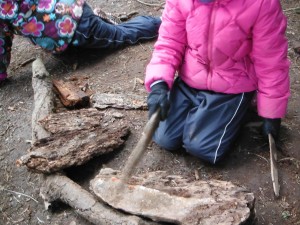“Ms. Van Stone, Ms. Van Stone listen, listen…” A child runs towards me with two small sticks; the group stops and waits. She hits the sticks together to make a sounds and everyone stands and listens intensely. The sound is so quiet children have to bend over to hear it more clearly. She then stops and then changes the sounds to make a different pattern. “Rub, rub, tap, tap, rub, rub, tap, tap!” a child says as he mimics the pattern with his hands.
Further down the trail another child finds a hollow branch. “Listen!” he hits a stick on either side of the branch. “If I bang it here, it sounds different then there. I could make a song” he says. This thought made me wonder if the child thought that two different sounds are needed for a song. I wondered what connections were made when he made this assumption. “I wonder why that made different sounds?” a child asks. “Because one is hollow and the other is full of water” a child suggests. “I think that it is because it is skinny on one side” another suggests.
Since September the children have been exploring the sounds of the forest, but more recently they have been intrigued about the sounds that they themselves can create in the forest. They use sticks, rocks, pinecones, branches, the ground, roots and trees to make many different sounds. It has been wonderful to listen to them create questions about different sounds, such as what makes sounds and what sounds is. We have been aware of them really listening to sounds, and watching their ability to recognize tone differences and predicts surrounding sound. They are also connecting the sounds they are making to musical instruments. “This sound reminds me of a drum, and this one is a flute”.
This growing confidence in creating sounds has transferred to the children being outstanding musical performers! Many mornings you can find children practicing songs during play time, and performing them later in the morning for the whole class. Everyone has a role, there are performers, lights people, people handing out popcorn or drinks, introducers, drummers, singers, audience members and dancers. Everyday these roles change, and the children have a great ability to regulate who is doing what. Amazingly it is all different children who prepare and perform for the group. Even the quietest children are willing to belt out their favorite songs, while the other children cheer them on. I feel as though the forest allows these children to notice many different types of sounds and the being in nature provides the opportunity to freely explore, wonder and question what sound is all about.







